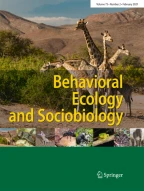Abstract.
Since nectar constitutes a highly variable resource, forager honeybees (Apis mellifera) always adjust their social foraging activities according to the current profitability of the nectar sources they exploit. If trophallaxis, food exchange among individuals of the same colony, serves to improve the coordination among nectar foragers, as occurs with the dance behavior, a high correlation might be expected between the foragers' trophallactic behavior and the profitability of the food sources they exploited. The aim of this work was to analyze whether a forager bee changes her trophallactic behavior with the varying profitability of a food source. In addition, since food source profitability affects dance behavior, we also analyzed the degree of coupling between the trophallactic and dance behavior of returning honeybees. Results show that trophallaxis by forager bees inside the hive changed rapidly with fluctuations in food source profitability. After an increase in profitability, returning foragers (1) increased the number of trophallactic offering contacts, (2) decreased the average duration of offering contacts, (3) shifted the temporal distribution of offering contacts from being mainly near the beginning of the time in the hive to being more evenly distributed throughout the entire visit, (4) begged for food less frequently, and (5) shifted their begging toward the very end of the visit. Regarding their dance behavior, foragers danced earlier in their visits to the hive and performed more waggle runs when the profitability of the food source was increased. Furthermore, the trophallactic and dance behaviors were affected not only by the absolute profitability of the food source but also by changes in profitability. Taken together, these results indicate that, in addition to dance behavior, short trophallactic interactions of returning foragers (which include both offering and begging contacts) may help foragers to communicate information about rapidly fluctuating resource opportunities.
Similar content being viewed by others
Author information
Authors and Affiliations
Additional information
Electronic Publication
Rights and permissions
About this article
Cite this article
De Marco, R., Farina, W. Changes in food source profitability affect the trophallactic and dance behavior of forager honeybees (Apis mellifera L.). Behav Ecol Sociobiol 50, 441–449 (2001). https://doi.org/10.1007/s002650100382
Received:
Revised:
Accepted:
Issue Date:
DOI: https://doi.org/10.1007/s002650100382
